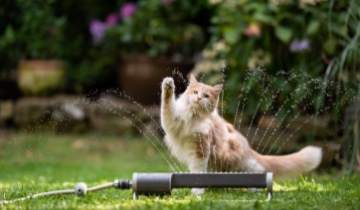Maintaining a regular grooming routine is a great way to help your pet stay cool over the summer.
With summer comes more adventures for your pets, whether it is a solo cat patrol of their local haunts or your dog joining you for a beach trip. More time outside in the sun and warmth means your fur-baby is going to be more exposed to sun, heat and dirt. The right grooming routine for your pet will help them stay clean, cool and comfortable over the summer months.
With these easy summer grooming tips, you’ll help your cat or dog to look and feel great this summer.
Brush your pet regularly
Regular brushing is a summer essential. As the weather gets warmer, your pet will begin shedding their heavy winter coat. At this time of year, you’ll probably notice that you and your furniture gain this excess fluff!
Brushing your pet two or three times a week will not only help get rid of this extra fur in an orderly manner, but also get rid of dirt, distribute natural oils throughout their coat and improve their skin condition. Plus it’ll help keep them cool on those warm summer days.
For your cat, regular brushing also gives you the opportunity to check they’re ok – making sure that their nails & paws are in good condition, and they haven’t been in a fight you aren’t aware of. If you have a long-haired cat, brushing regularly is even more important as you remove excess fur and helps prevent fur balls.
Invest in professional grooming
If your pet needs their hair shaved or trimmed, it’s best to hire a professional groomer.
Your pet’s fur is an insulator in both summer and winter. Their coat can help keep them cool and prevent sunburn, so your pet should never be shaved completely. A professional groomer will be able to advise you on the best summer hairstyle for your furry bestie because the ideal length depends on their breed and coat type.
A professionally groomed cat or dog is less likely to pick up ticks and fleas, and they’ll avoid getting overgrown or matted fur. Most groomers will also offer nail trimming and let’s face it – if your pet hates their nails being trimmed, it’s easier to leave this to a professional so you can remain Chief of Treats and Hugs
Bath time and cleaning
It’s tempting to bathe your pet more regularly during summer, but try to stick to your regular bathing routine. Some pets will need more baths than others, depending on their breed and what they get up to in the summer.
Bath time is a good opportunity for you to check your dog’s condition. Check between their toes for ticks or debris and check their paws, nails and skin condition. Dogs that love to swim are prone to swimmer’s ear and other ear infections, so make a point to check their ears regularly and gently wipe them after they’ve been for a dip.
Cats groom themselves, so – as a general rule – they don’t need baths. Spot cleaning is best if your cat has brushed against something mucky. If your cat has rolled in something smelly or they’ve picked up parasites, it might be a good idea to bathe them.
If you do bathe your pet, make sure you’re using pet-friendly shampoo or cleansing products. Always rinse their fur thoroughly afterwards, so there’s no soapy residue left on their coat that could cause skin irritation.
Summer pet diet
Your pet’s diet plays an important part in the health of their skin and fur.
Cats and dogs need a diet that’s high in protein, contains a moderate amount of fat and is low in carbohydrates. A good diet will help keep their coat healthy and shiny and this will mean less shedding.
In summer, make sure they drink a good amount of water. If your pet enjoys wet food, try feeding them it more often in summer. Some pets reduce the amount they eat in summer, so make sure what you do feed your pet is nutritious and contains the vitamins and minerals they need to stay fit and healthy.
Watch out for grass seeds
In late spring and summer dog parents in particular need to be wary of grass seeds and burs.
Pets can get painful wounds and infections from grass seeds. This is because grass seeds have pointed (and sometimes barbed) ends that can penetrate your pet’s skin. The small wounds can become infected and grass seeds can travel inside your pet’s body, causing trouble wherever they go. In many cases, surgery is required to remove the seed.
In 2021, we paid out more than $171,000 in grass-seed-related claims.
Pets with long coats are particularly susceptible as their luxurious locks pick up grass seeds as they run through long grass (anything longer than a standard lawn).
Grooming your pet after they’ve been playing in long grass is a good opportunity to check for any grass seeds stuck in their skin or coat. Paw pads, between the toes, legs and bellies are common problem areas. A well-groomed pet is also less likely to pick up grass seeds in their coat.
Pet grooming is important during summer
In the warmer months, grooming is important to help your pet keep their fur clean and well-maintained. Their coat helps keep their skin in good condition, it can help cool them down and prevent sunburn. By following these five simple tips, you can help your pet look great and feel great this summer.
Reference
National Library of Medicine, (accessed October 2022), https://www.ncbi.nlm.nih.gov/pmc/articles/PMC6849757/
PetMD, (accessed October 2022), https://www.petmd.com/blogs/nutritionnuggets/dr-coates/2015/june/what-feed-your-dog-healthy-skin-32814
PetMD, (accessed October 2022), https://www.petmd.com/dog/conditions/skin/your-pets-excessive-shedding-sign-illness
VCA Animal Hospitals, (accessed October 2022), https://vcahospitals.com/know-your-pet/coat-and-skin-appearance-in-the-healthy-dog



